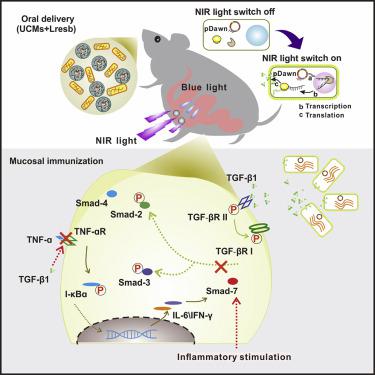Cell Reports ( IF 7.5 ) Pub Date : 2021-09-14 , DOI: 10.1016/j.celrep.2021.109690 Meihui Cui 1 , Tao Sun 2 , Shubin Li 3 , Huizhuo Pan 1 , Jing Liu 1 , Xinyu Zhang 1 , Lianyue Li 1 , Shanshan Li 4 , Chunyang Wei 4 , Chengzhuang Yu 4 , Chun Yang 1 , Ning Ma 1 , Binglin Ma 1 , Shenjunjie Lu 1 , Jin Chang 1 , Weiwen Zhang 2 , Hanjie Wang 1

|
Recombinant bacterial colonization plays an indispensable role in disease prevention, alleviation, and treatment. Successful application mainly depends on whether bacteria can efficiently spatiotemporally colonize the host gut. However, a primary limitation of existing methods is the lack of precise spatiotemporal regulation, resulting in uncontrolled methods that are less effective. Herein, we design upconversion microgels (UCMs) to convert near-infrared light (NIR) into blue light to activate recombinant light-responsive bacteria (Lresb) in vivo, where autocrine “functional cellular glues” made of adhesive proteins assist Lresb inefficiently colonizing the gut. The programmable engineering platform is further developed for the controlled and effective colonization of Escherichia coli Nissle 1917 (EcN) in the gut. The colonizing bacteria effectively alleviate DSS-induced colitis in mice. We anticipate that this approach could facilitate the clinical application of engineered microbial therapeutics to accurately and effectively regulate host health.
中文翻译:

具有活性生物胶涂层的近红外光响应细菌可在肠道中精确定植
重组细菌定植在疾病的预防、缓解和治疗中发挥着不可或缺的作用。成功的应用主要取决于细菌是否能够在时空上有效地定殖宿主肠道。然而,现有方法的主要限制是缺乏精确的时空调节,导致不受控制的方法效果不佳。在此,我们设计了上转换微凝胶 (UCM),将近红外光 (NIR) 转换为蓝光,从而在体内激活重组光响应细菌 (Lresb) ,其中由粘附蛋白制成的自分泌“功能性细胞胶”帮助 Lresb 低效地定殖肠子。可编程工程平台进一步开发用于大肠杆菌的可控和有效定植Nissle 1917 (EcN) 在肠道中。定植细菌有效缓解 DSS 诱导的小鼠结肠炎。我们预计这种方法可以促进工程微生物疗法的临床应用,以准确有效地调节宿主健康。











































 京公网安备 11010802027423号
京公网安备 11010802027423号